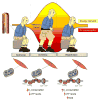Disruption of mitochondrial quality control in peripheral artery disease: New therapeutic opportunities
- PMID: 27876411
- PMCID: PMC5205542
- DOI: 10.1016/j.phrs.2016.11.016
Disruption of mitochondrial quality control in peripheral artery disease: New therapeutic opportunities
Abstract
Peripheral artery disease (PAD) is a multifactorial disease initially triggered by reduced blood supply to the lower extremities due to atherosclerotic obstructions. It is considered a major public health problem worldwide, affecting over 200 million people. Management of PAD includes smoking cessation, exercise, statin therapy, antiplatelet therapy, antihypertensive therapy and surgical intervention. Although these pharmacological and non-pharmacological interventions usually increases blood flow to the ischemic limb, morbidity and mortality associated with PAD continue to increase. This scenario raises new fundamental questions regarding the contribution of intrinsic metabolic changes in the distal affected skeletal muscle to the progression of PAD. Recent evidence suggests that disruption of skeletal muscle mitochondrial quality control triggered by intermittent ischemia-reperfusion injury is associated with increased morbidity in individuals with PAD. The mitochondrial quality control machinery relies on surveillance systems that help maintaining mitochondrial homeostasis upon stress. In this review, we describe some of the most critical mechanisms responsible for the impaired skeletal muscle mitochondrial quality control in PAD. We also discuss recent findings on the central role of mitochondrial bioenergetics and quality control mechanisms including mitochondrial fusion-fission balance, turnover, oxidative stress and aldehyde metabolism in the pathophysiology of PAD, and highlight their potential as therapeutic targets.
Keywords: 4-Hydroxynonenal; Mitochondrial dynamics; Mitochondrial metabolism; Mitophagy; Myocyte; Redox balance.
Copyright © 2016 Elsevier Ltd. All rights reserved.
Conflict of interest statement
Daria Mochly-Rosen filed patents on ALDH2 activators and is in a process of licensing these. The other authors declare that they have no conflicts of interest with the contents of this article.
Figures



Similar articles
-
Targeting Mitochondrial Dynamics during Lower-Limb Ischemia Reperfusion in Young and Old Mice: Effect of Mitochondrial Fission Inhibitor-1 (mDivi-1).Int J Mol Sci. 2024 Apr 4;25(7):4025. doi: 10.3390/ijms25074025. Int J Mol Sci. 2024. PMID: 38612835 Free PMC article.
-
Chronology of mitochondrial and cellular events during skeletal muscle ischemia-reperfusion.Am J Physiol Cell Physiol. 2016 Jun 1;310(11):C968-82. doi: 10.1152/ajpcell.00356.2015. Epub 2016 Apr 13. Am J Physiol Cell Physiol. 2016. PMID: 27076618 Free PMC article. Review.
-
Skeletal Muscle Pathology in Peripheral Artery Disease: A Brief Review.Arterioscler Thromb Vasc Biol. 2020 Nov;40(11):2577-2585. doi: 10.1161/ATVBAHA.120.313831. Epub 2020 Sep 17. Arterioscler Thromb Vasc Biol. 2020. PMID: 32938218 Free PMC article. Review.
-
Increased skeletal muscle mitochondrial free radical production in peripheral arterial disease despite preserved mitochondrial respiratory capacity.Exp Physiol. 2018 Jun;103(6):838-850. doi: 10.1113/EP086905. Epub 2018 May 8. Exp Physiol. 2018. PMID: 29604234 Free PMC article.
-
Intermittent claudication: new targets for drug development.Drugs. 2013 Jul;73(10):999-1014. doi: 10.1007/s40265-013-0078-3. Drugs. 2013. PMID: 23775528 Review.
Cited by
-
Mitochondrial Bioenergetics in the Metabolic Myopathy Accompanying Peripheral Artery Disease.Front Physiol. 2017 Mar 13;8:141. doi: 10.3389/fphys.2017.00141. eCollection 2017. Front Physiol. 2017. PMID: 28348531 Free PMC article. Review.
-
Targeting Mitochondrial Dynamics during Lower-Limb Ischemia Reperfusion in Young and Old Mice: Effect of Mitochondrial Fission Inhibitor-1 (mDivi-1).Int J Mol Sci. 2024 Apr 4;25(7):4025. doi: 10.3390/ijms25074025. Int J Mol Sci. 2024. PMID: 38612835 Free PMC article.
-
Mitochondrial protection by simvastatin against angiotensin II-mediated heart failure.Br J Pharmacol. 2019 Oct;176(19):3791-3804. doi: 10.1111/bph.14781. Epub 2019 Aug 24. Br J Pharmacol. 2019. PMID: 31265743 Free PMC article.
-
Resveratrol and Brain Mitochondria: a Review.Mol Neurobiol. 2018 Mar;55(3):2085-2101. doi: 10.1007/s12035-017-0448-z. Epub 2017 Mar 10. Mol Neurobiol. 2018. PMID: 28283884 Review.
-
Myeloid DRP1 deficiency limits revascularization in ischemic muscles via inflammatory macrophage polarization and metabolic reprogramming.JCI Insight. 2025 Jan 9;10(1):e177334. doi: 10.1172/jci.insight.177334. JCI Insight. 2025. PMID: 39589842 Free PMC article.
References
-
- Hiatt WR, Goldstone J, Smith SC, Jr, McDermott M, Moneta G, Oka R, Newman AB, Pearce WH G American Heart Association Writing. Atherosclerotic Peripheral Vascular Disease Symposium II: nomenclature for vascular diseases. Circulation. 2008;118(25):2826–2829. - PubMed
-
- Fowkes FG, Rudan D, Rudan I, Aboyans V, Denenberg JO, McDermott MM, Norman PE, Sampson UK, Williams LJ, Mensah GA, Criqui MH. Comparison of global estimates of prevalence and risk factors for peripheral artery disease in 2000 and 2010: a systematic review and analysis. Lancet. 2013;382(9901):1329–1340. - PubMed
-
- Gardnerand ET, Poehlman AW. Exercise rehabilitation programs for the treatment of claudication pain. A meta-analysis. Jama. 1995;274(12):975–980. - PubMed
-
- Brunelleand JA, Mulgrew CL. Exercise for intermittent claudication. Phys Ther. 2011;91(7):997–1002. - PubMed
-
- Smith GD, Shipley MJ, Rose G. Intermittent claudication, heart disease risk factors, and mortality. The Whitehall Study. Circulation. 1990;82(6):1925–1931. - PubMed
Publication types
MeSH terms
Substances
Grants and funding
LinkOut - more resources
Full Text Sources
Other Literature Sources
Medical

